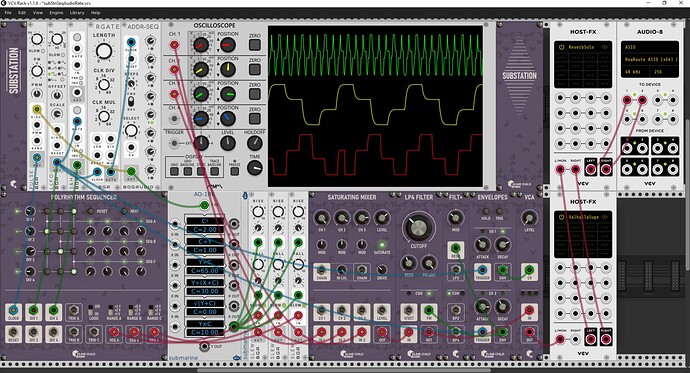Another Subharmonicon Emulator example. This is actually the first setup that later spawned my previous emulator posts. This original patch has a cool bass line with a timbre that I really like. The night I created it I was having fun jamming along with my flutes, thinking it sounded really good. But days later when I was prepping for a live performance on the Virtual Open Mic (VOM), I couldn’t recapture the moment and moved on to the ambient piece instead.
So now I decided to script different scenes for the original patch and finally post a synth demo without flutes.
Subharmonicon jam.vcv (322.6 KB)
This patch uses the exact same rhythm settings, VCO and Sub frequency/division settings, sequencer settings, and patch bay patches as my prior two emulator posts. But now the tempo is 393 BPM instead of 25 or 100. Obviously the envelope generator settings needed to change, and the Valhalla Supermassive is now in VCV Host so I can easily modulate various delay/reverb parameters with CV. It should be possible to accomplish the same thing using free modules while keeping Supermassive in my DAW (Reaper), but this was easier.
The patch bay has the following patches:
- VCA envelope out is patched to the filter drive
- Sub 2A V/Oct out is patched to VCO1 FM
- Sub 2B V/Oct out is patched to VCO1 Sync (both the base oscillator as well as the square/PWM oscillator)
- All rhythm trigger outs are XORed to detect when the rhythm sequence cycles back to the origin, and is used to trigger the next scene selection.
- The clock is used to sync the Valhalla Supermassive delay/reverb plugin
The FM and Sync modulation can be switched on and off. When on it gives the bass line that I like so much.
The rhythm pattern cycles back to the origin every 360 clock ticks, at which point a new scene is activated by the Stoermelder TRANSIT module. The sequencer takes 720 clock ticks to cycle back to the origin in relation to the rhythm generator.
Each scene specifies a particular combination of waveform and PWM selection, assignment of sequences to sub oscillator division selection, enable or disable the FM and hard sync, volume (distortion) levels, and delay/reverb parameters.
Scene 4 is pretty wild!
For those that don’t have the VCV Host, Supermassive is set to the Default preset with mode=Hydra. Low (HPF)=320Hz and High (LPF)=7250 Hz, Mod rate = 0.5 Hz, Depth=50%, Feedback=39%, Density 50%, Width=100%. For most of the scenes the Mix=30%, Delay=1/4 Note, Warp=15%. For scene 4 the Mix=50%, Delay=1/32 Note, Warp=0%. For scene 5 the Delay=1/8 Note and the Mix and Warp revert to 30% and 15%.












